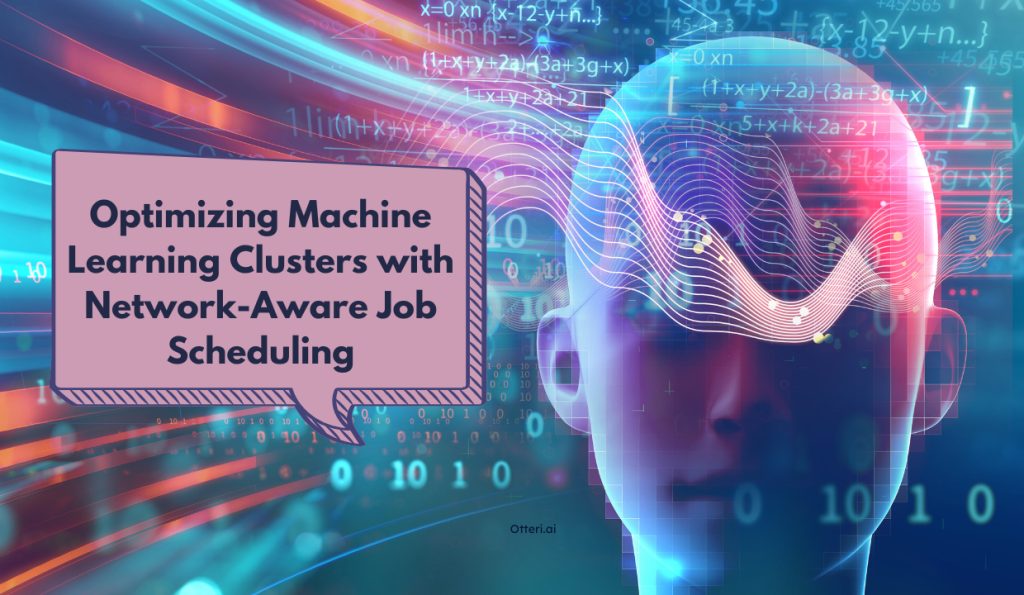
Network-aware job scheduling improves the efficiency of machine learning clusters by reducing congestion, optimizing resource allocation, and accelerating job completion times. Learn how this approach enhances distributed ML workloads.
As machine learning models become more complex, the need for efficient resource management in computing clusters is increasing. Traditional job scheduling methods focus on optimizing compute resources but often overlook network constraints. This can lead to network congestion, communication bottlenecks, and inefficient resource utilization, ultimately slowing down model training and increasing costs.
Network-aware job scheduling addresses these challenges by considering real-time network conditions, optimizing task placement, and reducing data transfer delays. This approach improves cluster efficiency, accelerates processing times, and ensures cost-effective use of computational resources.
This article explores the limitations of traditional job scheduling, the benefits of network-aware scheduling, its working principles, implementation strategies, real-world applications, and future trends.
Challenges with Traditional Job Scheduling in ML Clusters
Job scheduling in ML clusters involves assigning training and inference tasks to available computational resources such as GPUs, TPUs, and CPUs. A scheduler ensures workload distribution across the cluster to balance job execution times and optimize hardware utilization.
Traditional scheduling methods, such as FIFO (First In, First Out), fair scheduling, priority-based scheduling, and deadline-based scheduling, primarily focus on compute resource allocation. However, they do not consider network conditions, which can cause significant delays due to inefficient data transfers and congestion.
Without network-aware scheduling, ML workloads suffer from slow execution, increased resource contention, and unnecessary data movement, leading to poor cluster performance and higher operational costs.
Why Network-Aware Scheduling is Essential for ML Workloads
Large-scale ML tasks require frequent data exchanges across nodes for parameter synchronization, data shuffling, and gradient updates. Without network-aware scheduling, excessive communication overhead can reduce training efficiency.
By integrating network awareness into scheduling, organizations can minimize bottlenecks, optimize data locality, accelerate job completion, enhance resource utilization, and reduce cloud computing expenses. These improvements lead to faster training times and more efficient use of infrastructure.
How Network-Aware Job Scheduling Works
A network-aware scheduler incorporates real-time network monitoring, data locality awareness, adaptive load balancing, and predictive traffic modeling. These components help in making intelligent scheduling decisions that prevent network congestion and ensure smooth execution of ML jobs.
The scheduling process begins when a new ML task is submitted. The scheduler evaluates available compute and network resources before assigning jobs based on bandwidth availability, data locality, and node performance. Once assigned, continuous monitoring ensures that job placements are adjusted dynamically to avoid congestion. Performance data is logged to improve future scheduling decisions.
This adaptive approach ensures that network utilization remains optimized while maintaining computational efficiency.
Strategies for Implementing Network-Aware Job Scheduling
One effective strategy is optimizing network topology to minimize congestion. Using hierarchical or tree-based topologies, assigning jobs within the same rack, and placing frequently communicating tasks closer together can significantly improve efficiency.
Another approach involves reducing bandwidth overhead in distributed training. Techniques such as gradient compression, asynchronous training, and local aggregation help reduce data transfer sizes and synchronization delays.
Enhancing job schedulers for network awareness is also important. Existing schedulers like Kubernetes, Apache Spark, Ray, SLURM, and Mesos can be modified to consider network congestion when making task assignments.
AI-driven predictive scheduling can further improve efficiency by forecasting network congestion and making proactive scheduling decisions. Technologies like DeepRM and Gavel leverage machine learning to balance compute and network constraints dynamically.
Challenges in Network-Aware Job Scheduling
Despite its benefits, implementing network-aware scheduling comes with challenges. Integrating real-time network monitoring requires modifying existing algorithms and incorporating additional data collection tools, which increases complexity.
Network conditions are unpredictable, making it difficult to create scheduling models that consistently optimize performance. Balancing compute and network constraints is another challenge, as a job may have optimal compute resources but suboptimal network conditions.
Continuous monitoring also adds resource overhead, requiring efficient data management techniques to avoid unnecessary performance degradation.
Real-world applications of Network-Aware Scheduling
Several companies have successfully implemented network-aware job scheduling to optimize ML workloads.
Google uses bandwidth-aware scheduling for TensorFlow’s distributed training, significantly improving training times.
Meta’s FairScale library for PyTorch leverages network-aware scheduling to enhance large-scale deep learning efficiency.
Microsoft Azure integrates bandwidth-aware job placement into its cloud services to reduce costs and improve system performance.
These examples highlight the real-world impact of network-aware scheduling on large-scale machine-learning operations.
Future of Network-Aware Job Scheduling
As machine learning workloads continue to grow, the adoption of network-aware scheduling is expected to increase. The integration of edge computing will optimize ML workloads across both cloud and edge environments.
AI-driven adaptive scheduling will automate and refine job scheduling decisions using deep learning models. Advances in high-speed networking, such as 5G and next-generation Ethernet, will further reduce latency and improve data transfer speeds.
These innovations will continue to enhance the efficiency of ML clusters, making network-aware scheduling a critical component of future AI infrastructure.
Final Thoughts
Network-aware job scheduling is transforming machine learning clusters by addressing network bottlenecks, improving resource utilization, and accelerating distributed training. By considering real-time bandwidth constraints alongside compute resources, organizations can significantly improve the efficiency of their ML workloads.
As AI infrastructure continues to scale, implementing network-aware scheduling strategies will be essential for reducing training times, optimizing costs, and ensuring the smooth operation of machine learning clusters.
Looking for intelligent job scheduling solutions? Otteri.ai provides AI-powered scheduling tools to optimize ML workloads with real-time resource management. Explore how Otteri.ai can enhance your machine-learning infrastructure today.